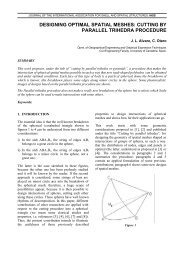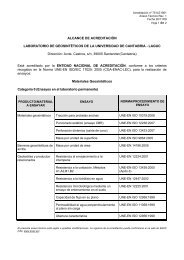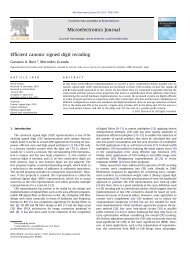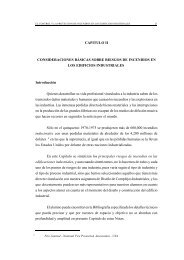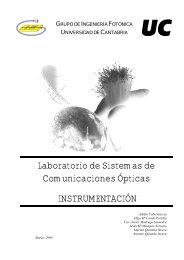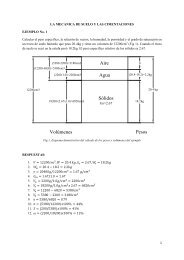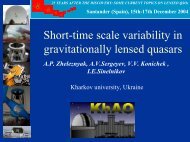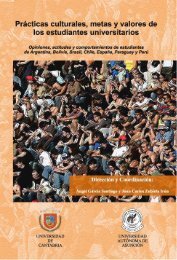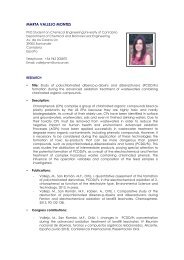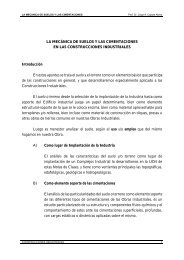XXXVII <str<strong>on</strong>g>IAHS</str<strong>on</strong>g><str<strong>on</strong>g>World</str<strong>on</strong>g> <str<strong>on</strong>g>C<strong>on</strong>gress</str<strong>on</strong>g> <strong>on</strong> <strong>Housing</strong>October 26 – 29, 2010, Santan<strong>de</strong>r, SpainCODE: 281ENERGY EFFICIENCY-BASED FULL REFURBISHMENT OFLIFTS IN EXISTING BUILDINGSJosé Alberto Roig 1 , Pedro G<strong>on</strong>zález 2 , Ana María Lorente 31,2 Dirección Técnica Ascensor Completo1,2 MP Lifts, Spain1 e-mail: jar@mpcorporaci<strong>on</strong>,com ; 2 e-mail: pgc@mpcorporaci<strong>on</strong>.com3 Department of Product Mechatr<strong>on</strong>ic Design3 Instituto Tecnológico <strong>de</strong> Aragón, Spain3 e-mail: alorente@ita.esKey words: Lift (Elevator), Energy Efficiency, Eco<strong>de</strong>sign, Envir<strong>on</strong>ment Protecti<strong>on</strong>, Life CycleAssessment (LCA), Envir<strong>on</strong>mental Impact, New Technologies, Full RefurbishmentAbstractThe Lift (Elevator) is the main means of transport insi<strong>de</strong> our current city buildings. In resi<strong>de</strong>ntialenvir<strong>on</strong>ment the lift presence is totally necessary in or<strong>de</strong>r to accomplish with accessibility regulati<strong>on</strong>sfor disabled people. This means that not <strong>on</strong>ly the amount of worldwi<strong>de</strong> existing lifts but also thenumber of yearly manufactured units must be taken in c<strong>on</strong>si<strong>de</strong>rati<strong>on</strong>. On the other hand, the liftoperati<strong>on</strong> represents a substantial percentage of the energy c<strong>on</strong>sumpti<strong>on</strong> in a building. Neverthelessthe opportunities for increasing Energy Efficiency in lifts, especially in existing <strong>on</strong>es, are enormous.The European Uni<strong>on</strong> is currently ruling with focus <strong>on</strong> Eco<strong>de</strong>sign and Envir<strong>on</strong>mental Protecti<strong>on</strong> bymeans of the Directive 2009/125/EC, applied to energy-related products, that supports the introducti<strong>on</strong>of product Life Cycle Assessment to value their Ecological Profile. The applicati<strong>on</strong> of LCAmethodologies to the lift proves that the biggest Envir<strong>on</strong>mental Impact c<strong>on</strong>cerns to the use-phase. Thisfact points directly to the improvement of energy efficiency. In new installati<strong>on</strong> lifts this objective hasalready been achieved through exhaustive use of brand new tracti<strong>on</strong> technologies, new materials forfricti<strong>on</strong> reducti<strong>on</strong> and c<strong>on</strong>trol systems upgrading. However this is not the same for existing lifts wherethese improvements are being very slowly and partially introduced.This paper proposes a set of measures to un<strong>de</strong>rtake the Full Refurbishment of lifts in existing buildingswith the main aim of improving the whole energy efficiency of the building. These measures can beadopted in different progressive phases or stages:1. Selecti<strong>on</strong> and <strong>de</strong>velopment of the most efficient lift arrangement2. Use of new materials (high performance, recyclability, high strength-weight ratio)3. Applicati<strong>on</strong> of New Technologies (tracti<strong>on</strong> and lighting)4. Substantial reducti<strong>on</strong> of stand-by energy c<strong>on</strong>sumpti<strong>on</strong>5. Use of electric energy recovering systems in cases where lift motor works as generatorFinally <strong>on</strong>-site verified results of the respective energy savings are presented.37º <str<strong>on</strong>g>IAHS</str<strong>on</strong>g> <str<strong>on</strong>g>World</str<strong>on</strong>g> <str<strong>on</strong>g>C<strong>on</strong>gress</str<strong>on</strong>g> On <strong>Housing</strong> Science 163
XXXVII <str<strong>on</strong>g>IAHS</str<strong>on</strong>g><str<strong>on</strong>g>World</str<strong>on</strong>g> <str<strong>on</strong>g>C<strong>on</strong>gress</str<strong>on</strong>g> <strong>on</strong> <strong>Housing</strong>October 26 – 29, 2010, Santan<strong>de</strong>r, SpainCODE: 282EVOLUTION AND SUSTAINABILITY OF IN-SITUCONCRETE FLAT SLABS IN OFFICE BUILDINGSLiébana, O. 1 ; G. Pulido 1 , MD; Gómez Hermoso J. 21University of San Pablo CEU (Madrid), 2 University Politécnica <strong>de</strong> Madrid1 e-mail: oliebana@ceu.es,Key words: in-situ c<strong>on</strong>crete, sustainability, flat slab, minimum reinforcing ratios, CO 2 emissi<strong>on</strong>AbstractIn the current office building c<strong>on</strong>structi<strong>on</strong> practice, flat plate is the most comm<strong>on</strong> floorstructural system due to its ec<strong>on</strong>omic and practical advantages. Traditi<strong>on</strong>ally, high materialcosts have had a great impact <strong>on</strong> total c<strong>on</strong>structi<strong>on</strong> cost, so voi<strong>de</strong>d opti<strong>on</strong>s as ribbed or waffleslab have been used extensively. However, recently there is a ten<strong>de</strong>ncy to <strong>de</strong>sign solid slabsopti<strong>on</strong>s, especially due to rising labor costs, simpler and quicker c<strong>on</strong>structi<strong>on</strong>, which reducesexecuti<strong>on</strong> timeframe and increases c<strong>on</strong>structi<strong>on</strong> safety.The use of post-tensi<strong>on</strong>ed (PT) floors in building structures has been growing in recent years.This type of c<strong>on</strong>structi<strong>on</strong> allows thinner slabs and thus, it creates lighter structures, produces alarge reducti<strong>on</strong> in rebar t<strong>on</strong>nage, with the subsequent advantages in transportati<strong>on</strong>, storage orlabor. Also, these slabs have other advantages as reduced cracking and <strong>de</strong>flecti<strong>on</strong>s, reducedfloor to floor height or quick c<strong>on</strong>structi<strong>on</strong>. In most countries these <strong>de</strong>sign mechanical an<strong>de</strong>c<strong>on</strong>omical features have enabled the system to compete ec<strong>on</strong>omically with traditi<strong>on</strong>al in-situc<strong>on</strong>crete floor slabs; however, this is not the case in some other countries like Spain.Introducti<strong>on</strong> of sustainability criteria and specializati<strong>on</strong> in c<strong>on</strong>structi<strong>on</strong> can allow for thissystem to be introduced in the market, which can also mean lower costs, improvedperformance and focusing <strong>on</strong> sustainability in c<strong>on</strong>structi<strong>on</strong>.Different soluti<strong>on</strong>s have been studied for an actual project, in terms of material quantities,minimum structural thickness and it has also been checked the impact of costs an<strong>de</strong>nvir<strong>on</strong>mental criteria based <strong>on</strong> CO 2 emissi<strong>on</strong>. With these data, we could assess that thecurrent status of low producti<strong>on</strong> of flat slabs in Spain it is not related to real ec<strong>on</strong>omicreas<strong>on</strong>s; it is actually related to a combinati<strong>on</strong> of reas<strong>on</strong>s as lack of technical knowledge of<strong>de</strong>signers or buil<strong>de</strong>rs, inc<strong>on</strong>sistencies or <strong>de</strong>ficiencies in current nati<strong>on</strong>al co<strong>de</strong>s in each country.The c<strong>on</strong>structi<strong>on</strong> industry is following an inertial period that resists changing known systems,apparently satisfactory, and that especially shows an unsustainable view of the c<strong>on</strong>structi<strong>on</strong>.Post-tensi<strong>on</strong>ed c<strong>on</strong>crete slabs will not always be the most suitable and sustainable opti<strong>on</strong>, butit should be evaluated while c<strong>on</strong>si<strong>de</strong>ring other more familiar techniques of c<strong>on</strong>structi<strong>on</strong> withupdated c<strong>on</strong>si<strong>de</strong>rati<strong>on</strong>s.37º <str<strong>on</strong>g>IAHS</str<strong>on</strong>g> <str<strong>on</strong>g>World</str<strong>on</strong>g> <str<strong>on</strong>g>C<strong>on</strong>gress</str<strong>on</strong>g> On <strong>Housing</strong> Science 164
- Page 1 and 2:
University ofCantabriawww.iahshousi
- Page 3 and 4:
ÍNDICE1. HONORARY COMMITTEE ______
- Page 5 and 6:
2. INTRODUCTIONThe International As
- Page 7:
4. ENTIDADES COLABORADORASColegio d
- Page 10 and 11:
6. ORGANIZING COMMITTEELOCAL ORGANI
- Page 12 and 13:
8. TOPICS - STATISTICSTOPIC I: MATE
- Page 14 and 15:
also the Spanish aristocracy used t
- Page 16 and 17:
11. CONFERENCE ROOMSThe Con
- Page 18 and 19:
Also, the Congress
- Page 20 and 21:
13. PLENARY SESSIONSPLENARY SESSION
- Page 22 and 23:
October 26, 9 h 30-10 h 00 (Room 0)
- Page 24 and 25:
October 26, 10 h 30-11 h 00 (Room 0
- Page 26 and 27:
October 27, 9 h 30-10 h 00 (Room 0)
- Page 28 and 29:
October 27, 10 h 30-11 h 00 (Room 0
- Page 30 and 31:
October 28, 9 h 30-10 h 00 (Room 0)
- Page 32 and 33:
October 28, 10 h 30-11 h 00 (Room 0
- Page 34 and 35:
October 26, 201011 h 30-13 h 30 Cha
- Page 36 and 37:
October 26, 201011 h 30-13 h 30 Cha
- Page 38 and 39:
October 27, 201011 h 30-13 h 30 Cha
- Page 40 and 41:
October 27, 201011 h 30-13 h 30 Cha
- Page 42 and 43:
October 28, 201011 h 30-13 h 30 Cha
- Page 44 and 45:
October 28, 201011 h 30-13 h 30 Cha
- Page 46 and 47:
16. TECHNICAL EXPOSITION (STANDS)37
- Page 48 and 49:
TRIP A: MARITIME MUSEUM + PEDREÑA
- Page 50 and 51:
RECEPTION COCKTAIL BY THE MAYOR OFS
- Page 52 and 53:
37º IAHS
- Page 54 and 55:
GALA DINNERDía 28 de OctubrePassin
- Page 56 and 57:
37º IAHS
- Page 58 and 59:
19. ABSTRACTS OF THE CONGRESSABSTRA
- Page 60 and 61:
XXXVII IAHS<strong
- Page 62 and 63:
XXXVII IAHS<strong
- Page 64 and 65:
XXXVII IAHS<strong
- Page 66 and 67:
XXXVII IAHS<strong
- Page 71 and 72:
XXXVII IAHS<strong
- Page 73 and 74:
XXXVII IAHS<strong
- Page 75 and 76:
XXXVII IAHS<strong
- Page 77 and 78:
XXXVII IAHS<strong
- Page 79 and 80:
XXXVII IAHS<strong
- Page 81 and 82:
XXXVII IAHS<strong
- Page 83 and 84:
XXXVII IAHS<strong
- Page 85 and 86:
XXXVII IAHS<strong
- Page 87 and 88:
XXXVII IAHS<strong
- Page 89 and 90:
XXXVII IAHS<strong
- Page 91 and 92:
XXXVII IAHS<strong
- Page 93 and 94:
XXXVII IAHS<strong
- Page 95 and 96:
XXXVII IAHS<strong
- Page 97 and 98:
XXXVII IAHS<strong
- Page 99 and 100:
XXXVII IAHS<strong
- Page 101 and 102:
XXXVII IAHS<strong
- Page 103 and 104:
XXXVII IAHS<strong
- Page 105 and 106:
XXXVII IAHS<strong
- Page 107 and 108:
XXXVII IAHS<strong
- Page 109 and 110:
XXXVII IAHS<strong
- Page 111 and 112:
XXXVII IAHS<strong
- Page 113 and 114:
XXXVII IAHS<strong
- Page 115 and 116: XXXVII IAHS<strong
- Page 117 and 118: XXXVII IAHS<strong
- Page 119 and 120: XXXVII IAHS<strong
- Page 121 and 122: XXXVII IAHS<strong
- Page 123 and 124: XXXVII IAHS<strong
- Page 125 and 126: XXXVII IAHS<strong
- Page 127 and 128: XXXVII IAHS<strong
- Page 129 and 130: XXXVII IAHS<strong
- Page 131 and 132: XXXVII IAHS<strong
- Page 133 and 134: XXXVII IAHS<strong
- Page 135 and 136: XXXVII IAHS<strong
- Page 137 and 138: XXXVII IAHS<strong
- Page 139 and 140: XXXVII IAHS<strong
- Page 141 and 142: XXXVII IAHS<strong
- Page 143 and 144: XXXVII IAHS<strong
- Page 145 and 146: XXXVII IAHS<strong
- Page 147 and 148: XXXVII IAHS<strong
- Page 149 and 150: XXXVII IAHS<strong
- Page 151 and 152: XXXVII IAHS<strong
- Page 153 and 154: XXXVII IAHS<strong
- Page 155 and 156: XXXVII IAHS<strong
- Page 157 and 158: XXXVII IAHS<strong
- Page 159 and 160: XXXVII IAHS<strong
- Page 161 and 162: XXXVII IAHS<strong
- Page 163 and 164: XXXVII IAHS<strong
- Page 165: XXXVII IAHS<strong
- Page 169 and 170: XXXVII IAHS<strong
- Page 171 and 172: XXXVII IAHS<strong
- Page 173 and 174: XXXVII IAHS<strong
- Page 175 and 176: XXXVII IAHS<strong
- Page 177 and 178: XXXVII IAHS<strong
- Page 179 and 180: XXXVII IAHS<strong
- Page 181 and 182: XXXVII IAHS<strong
- Page 183 and 184: XXXVII IAHS<strong
- Page 185 and 186: XXXVII IAHS<strong
- Page 187 and 188: XXXVII IAHS<strong
- Page 189 and 190: XXXVII IAHS<strong
- Page 191 and 192: XXXVII IAHS<strong
- Page 193 and 194: XXXVII IAHS<strong
- Page 195 and 196: XXXVII IAHS<strong
- Page 197 and 198: TOPIC IV - HEALTH, COMFORT AND SAFE
- Page 199 and 200: XXXVII IAHS<strong
- Page 201 and 202: XXXVII IAHS<strong
- Page 203 and 204: XXXVII IAHS<strong
- Page 205 and 206: XXXVII IAHS<strong
- Page 207 and 208: XXXVII IAHS<strong
- Page 209 and 210: XXXVII IAHS<strong
- Page 211 and 212: XXXVII IAHS<strong
- Page 213 and 214: XXXVII IAHS<strong
- Page 215 and 216: XXXVII IAHS<strong
- Page 217 and 218:
XXXVII IAHS<strong
- Page 219 and 220:
XXXVII IAHS<strong
- Page 221 and 222:
XXXVII IAHS<strong
- Page 223 and 224:
XXXVII IAHS<strong
- Page 225 and 226:
XXXVII IAHS<strong
- Page 227 and 228:
XXXVII IAHS<strong
- Page 229 and 230:
XXXVII IAHS<strong
- Page 231 and 232:
XXXVII IAHS<strong
- Page 233 and 234:
XXXVII IAHS<strong
- Page 235 and 236:
TOPIC VI - URBAN AND CITY PLANNING.
- Page 237 and 238:
XXXVII IAHS<strong
- Page 239 and 240:
XXXVII IAHS<strong
- Page 241 and 242:
XXXVII IAHS<strong
- Page 243 and 244:
XXXVII IAHS<strong
- Page 245 and 246:
XXXVII IAHS<strong
- Page 247 and 248:
XXXVII IAHS<strong
- Page 249 and 250:
XXXVII IAHS<strong
- Page 251 and 252:
XXXVII IAHS<strong
- Page 253 and 254:
XXXVII IAHS<strong
- Page 255 and 256:
XXXVII IAHS<strong
- Page 257 and 258:
XXXVII IAHS<strong
- Page 259 and 260:
XXXVII IAHS<strong
- Page 261 and 262:
XXXVII IAHS<strong
- Page 263 and 264:
XXXVII IAHS<strong
- Page 265 and 266:
TOPIC VII - ECONOMY AND FINANCING P
- Page 267 and 268:
XXXVII IAHS<strong
- Page 269 and 270:
XXXVII IAHS<strong
- Page 271 and 272:
XXXVII IAHS<strong
- Page 273 and 274:
TOPIC VIII - MANAGEMENT SCHEMES AND
- Page 275 and 276:
XXXVII IAHS<strong
- Page 277 and 278:
XXXVII IAHS<strong
- Page 279 and 280:
XXXVII IAHS<strong
- Page 281 and 282:
XXXVII IAHS<strong
- Page 283 and 284:
XXXVII IAHS<strong
- Page 285 and 286:
XXXVII IAHS<strong
- Page 287 and 288:
XXXVII IAHS<strong
- Page 289 and 290:
XXXVII IAHS<strong
- Page 291 and 292:
XXXVII IAHS<strong
- Page 293 and 294:
XXXVII IAHS<strong
- Page 295 and 296:
XXXVII IAHS<strong
- Page 297 and 298:
XXXVII IAHS<strong
- Page 299 and 300:
XXXVII IAHS<strong
- Page 301 and 302:
XXXVII IAHS<strong
- Page 303 and 304:
XXXVII IAHS<strong
- Page 305 and 306:
XXXVII IAHS<strong
- Page 307 and 308:
XXXVII IAHS<strong
- Page 309 and 310:
XXXVII IAHS<strong
- Page 311 and 312:
XXXVII IAHS<strong
- Page 313 and 314:
XXXVII IAHS<strong
- Page 315 and 316:
XXXVII IAHS<strong
- Page 317 and 318:
XXXVII IAHS<strong
- Page 319 and 320:
XXXVII IAHS<strong
- Page 321 and 322:
XXXVII IAHS<strong
- Page 323 and 324:
XXXVII IAHS<strong
- Page 325 and 326:
XXXVII IAHS<strong
- Page 327 and 328:
XXXVII IAHS<strong
- Page 329 and 330:
XXXVII IAHS<strong
- Page 331 and 332:
XXXVII IAHS<strong
- Page 333 and 334:
XXXVII IAHS<strong
- Page 335 and 336:
XXXVII IAHS<strong
- Page 337 and 338:
XXXVII IAHS<strong
- Page 339 and 340:
XXXVII IAHS<strong
- Page 341 and 342:
XXXVII IAHS<strong
- Page 343 and 344:
XXXVII IAHS<strong
- Page 345 and 346:
XXXVII IAHS<strong
- Page 347 and 348:
XXXVII IAHS<strong
- Page 349 and 350:
XXXVII IAHS<strong
- Page 351 and 352:
XXXVII IAHS<strong
- Page 353 and 354:
XXXVII IAHS<strong
- Page 355 and 356:
XXXVII IAHS<strong
- Page 357 and 358:
XXXVII IAHS<strong
- Page 359 and 360:
XXXVII IAHS<strong
- Page 361 and 362:
XXXVII IAHS<strong
- Page 363 and 364:
XXXVII IAHS<strong
- Page 365 and 366:
XXXVII IAHS<strong
- Page 367 and 368:
XXXVII IAHS<strong
- Page 369 and 370:
XXXVII IAHS<strong
- Page 371 and 372:
XXXVII IAHS<strong
- Page 373 and 374:
XXXVII IAHS<strong
- Page 375 and 376:
XXXVII IAHS<strong
- Page 377 and 378:
XXXVII IAHS<strong



